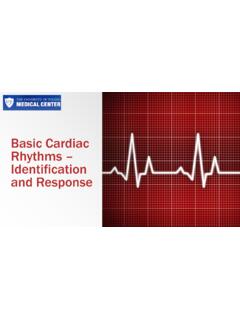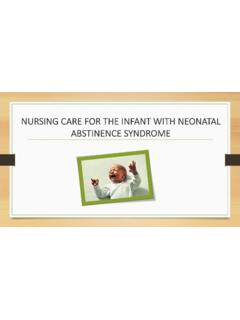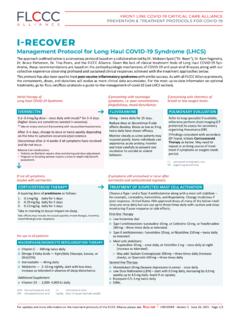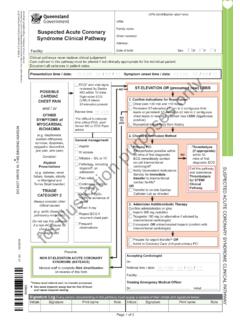Transcription of Advanced EKG Interpretation - University of Toledo
1 Advanced EKG Interpretation JUNCTIONAL RHYTHMS AND NURSING INTERVENTIONS Objectives Identify specific cardiac dysrhythmias Describe appropriate nursing interventions for specific dysrhythmias Junctional Rhythms Junctional rhythms are named such because their impulse originates from the AV node (AV junction) instead of the SA node. The SA node may be impaired secondary to drug toxicity or underlying cardiac disease. When the AV node does not sense an impulse coming down from the SA node, it will become the pacemaker of the heart. Characteristics of all Junctional Rhythms Inverted (negative) or absent P waves are seen before each QRS complex OR P wave can be hidden in the QRS complex OR P wave may follow the QRS complex PR interval of < seconds (remember normal is ) QRS complex within normal measurements Most Common Variations Junctional (escape) rhythm: 40 - 60 bpm Accelerated junctional rhythm: 61 100 bpm Junctional tachycardia : >100 bpm Premature junctional complexes (PJCs) Junctional Rhythm Junctional (escape) rhythms originate at or around the AV node and the Bundle of His.
2 The impulse travels up the atria and down to the ventricles resulting in inverted P waves that can occur prior to, during or after the QRS. P waves can also be absent if the impulse does not travel up into the atria. Inverted P wave 5 Steps to Identify Junctional Rhythm 1. What is the rate? 40-60 bpm 2. What is the rhythm? Regular 3. Is there a P wave before each QRS? Are P waves upright and uniform? Usually inverted or absent, may be before, during or after QRS complex 4. What is the length of the PR interval? Will be shortened, if occurs before QRS complex, otherwise not measurable 5. Do all QRS complexes look alike? What is the length of the QRS complexes? Yes Less than seconds (3 small squares) Causes and S/S of Junctional Rhythm Causes SA node disease Sick sinus syndrome Inferior wall MI Digitalis toxicity Vagal stimulation Signs and symptoms May be asymptomatic Chest pain Dyspnea Hypotension Altered level of consciousness Blurred vision Risk and Medical Tx of Junctional Rhythm Risk Reduced cardiac output Medical Treatment None if asymptomatic Treat the underlying cause Atropine Temporary or permanent pacemaker Accelerated Junctional Rhythm Accelerated junctional rhythms originate in the bundle of His and fire at a rate of 60 - 100bpm Note: no P waves 5 Steps to Identify Accelerated Junctional Rhythm 1.
3 What is the rate? 60-100 bpm 2. What is the rhythm? Regular 3. Is there a P wave before each QRS? Are P waves upright and uniform? Usually inverted or absent, may be before, during or after QRS complex 4. What is the length of the PR interval? Will be shortened, if occurs before QRS complex, otherwise not measurable 5. Do all QRS complexes look alike? What is the length of the QRS complexes? Yes Less than seconds (3 small squares) Causes and S/S of Accelerated Junctional Rhythm Causes SA node disease Digitalis toxicity Hypoxia Increased vagal tone Beta blockers and calcium channel blockers Hypokalemia Inferior or posterior wall MI Signs and symptoms May be asymptomatic Chest pain Dyspnea Hypotension Altered level of consciousness Weak peripheral pulses Risk and Medical Tx of Accelerated Junctional Rhythm Risk Reduced cardiac output Medical Treatment None if asymptomatic Treat the underlying cause Atropine Temporary or permanent pacemaker Junctional tachycardia Junctional tachycardia is a junctional rhythm with a rate between 101 - 180bpm Note.
4 Inverted P waves 5 Steps to Identify Junctional tachycardia 1. What is the rate? 101-180 bpm 2. What is the rhythm? Regular 3. Is there a P wave before each QRS? Are P waves upright and uniform? Usually inverted or absent, may be before, during or after QRS complex 4. What is the length of the PR interval? Will be shortened, if occurs before QRS complex, otherwise not measurable 5. Do all QRS complexes look alike? What is the length of the QRS complexes? Yes Less than seconds (3 small squares) Causes and S/S of Junctional tachycardia Causes Cardiac ischemia Hypoxia Increased vagal tone CHF Cardiogenic shock Signs and symptoms May be asymptomatic Chest pain Dyspnea Hypotension Altered level of consciousness Risk and Medical Tx of Junctional tachycardia Risk Reduced cardiac output Medical Treatment None if asymptomatic Treat the underlying cause Rate control Vagal maneuvers Verapamil Cardioversion Premature Junctional Contraction (PJC) A Premature Junctional Contraction is an early beat that occurs prior to the next sinus beat.
5 Similar to a PAC EXCEPT P wave is inverted on the PJC!! 5 Steps to Identify Premature Junctional Contraction (PJC) 1. What is the rate? Depends on underlying rhythm 2. What is the rhythm? Irregular noted during the PJC 3. Is there a P wave before each QRS? Are P waves upright and uniform? Usually inverted or absent, may be before, during or after QRS complex 4. What is the length of the PR interval? Will be shortened, if occurs before QRS complex, otherwise not measurable 5. Do all QRS complexes look alike? What is the length of the QRS complexes? Yes Less than seconds (3 small squares) Causes and S/S of Premature Junctional Contractions Causes May occur in healthy hearts Digitalis toxicity Cardiac ischemia MI Increased vagal tone CHF Cardiogenic shock Excessive caffeine Signs and symptoms Usually asymptomatic Based on underlying rhythm Risk and Medical Tx of Premature Junctional Contraction Risk If PJCs occur frequently.
6 Junctional tachycardia may result Medical Treatment No treatment required unless the PJCs become more frequent HEART BLOCK RHYTHMS AND NURSING INTERVENTIONS Objectives Identify specific cardiac dysrhythmias Describe appropriate nursing interventions for secific dysrhythmias The Heart Block Rhythms Heart blocks are arrhythmias caused by an interruption in the conduction of impulses between the atria and the ventricles. The AV block can be total or partial or it may simply delay conduction. The Heart Block Rhythms First Degree AV Block Second Degree AV Block Type I (Wenckebach) Type II Third Degree AV Block First Degree AV Block First Degree AV Block Is the most common form of heart block Looks similar to sinus rhythm Impulse conduction between the atria and the Bundle of His is delayed at the level of the AV node The PR interval will be prolonged (> ) 5 Steps to Identify First Degree AV Block 1.
7 What is the rate? Based on rate of underlying rhythm 2. What is the rhythm? Usually regular 3. Is there a P wave before each QRS? Are P waves upright and uniform? Yes Yes 4. What is the length of the PR interval? > seconds 5. Do all QRS complexes look alike? What is the length of the QRS complexes? Yes Less than seconds (3 small squares) Causes and S/S of First Degree AV Block Causes Can occur in healthy hearts May be temporary Myocardial infarction or ischemia Medications digitalis, calcium channel blockers, beta blockers Myocarditis Degenerative changes in the heart Signs and Symptoms Most patients are asymptomatic Dizziness/syncope Risk and Medical Tx of First Degree AV Block Risk Reduced cardiac output, although this is rare Treatment No treatment is usually necessary if the patient is asymptomatic Treat the underlying cause Monitor closely to detect progression to a more serious form of block 2nd Degree AV Block Mobitz Type I (Wenckeback)
8 The delay of the electrical impulse at the AV node produces a progressive increase in the length of the PR interval (> seconds) The PR interval continues to increase in length until the impulse is not conducted or the QRS complex is dropped Dropped QRS! Lengthening PR intervals 5 Steps to Identify 2nd Degree AV Block Mobitz Type I (Wenckebach) 1. What is the rate? Atrial: unaffected Ventricular: usually slower than atrial 2. What is the rhythm? Atrial: regular Ventricular: irregular 3. Is there a P wave before each QRS? Are P waves upright and uniform? Yes Yes, for conducted beats 4. What is the length of the PR interval? Progressively prolongs until a QRS is not conducted 5. Do all QRS complexes look alike? What is the length of the QRS complexes?
9 Yes Less than seconds (3 small squares) Causes and S/S of 2nd Degree AV Block Mobitz Type I (Wenckebach) Causes May occur normally in an otherwise healthy person Coronary artery disease Inferior wall MI Rheumatic fever Medications propanolol, digitalis, verapamil Increased vagal stimulation Signs and Symptoms Usually asymptomatic Lightheadedness Hypotension Symptoms may be more pronounced if the ventricular rate is slow Risk and Medical Tx of 2nd Degree AV Block Mobitz Type I (Wenckebach) Risk Reduced cardiac output, although this is uncommon Progression to 3rd degree block! Treatment No treatment is usually necessary if the patient is asymptomatic Treat the underlying cause Monitor closely to detect progression to a more serious form of block, especially if the block occurs during an MI If symptomatic Atropine may improve AV node conduction Temporary pacemaker may help with symptom relief until the rhythm resolves itself 2nd Degree AV Block Mobitz Type II Occurs when there is intermittent interruption of conduction Less common that a 2nd Degree Type 1 block, but more dangerous PR intervals are regular for conducted beats The atrial rhythm is regular The ventricular rhythm is irregular due to dropped or nonconducted (blocked)
10 Beats Will have constant PR intervals with randomly dropped QRS s 5 Steps to Identify 2nd Degree AV Block Mobitz Type II 1. What is the rate? Atrial: unaffected Ventricular: usually slower than atrial, bradycardic 2. What is the rhythm? Atrial: regular Ventricular: irregular 3. Is there a P wave before each QRS? Are P waves upright and uniform? Yes, some not followed by a QRS Yes, for conducted beats 4. What is the length of the PR interval? Constant for conducted beats 5. Do all QRS complexes look alike? What is the length of the QRS complexes? Yes, intermittently absent Less than or greater than seconds Causes and S/S of 2nd Degree AV Block Mobitz Type II Causes Anterior wall MI Degenerative changes in the conduction system Severe coronary artery disease Signs and Symptoms May be asymptomatic as long as cardiac output is maintained Palpitations Fatigue Dyspnea Chest pain Lightheadedness Hypotension Risk and Medical Tx of 2nd Degree AV Block Mobitz Type II Risk Reduced cardiac output Progression to 3rd degree AV block (complete)






